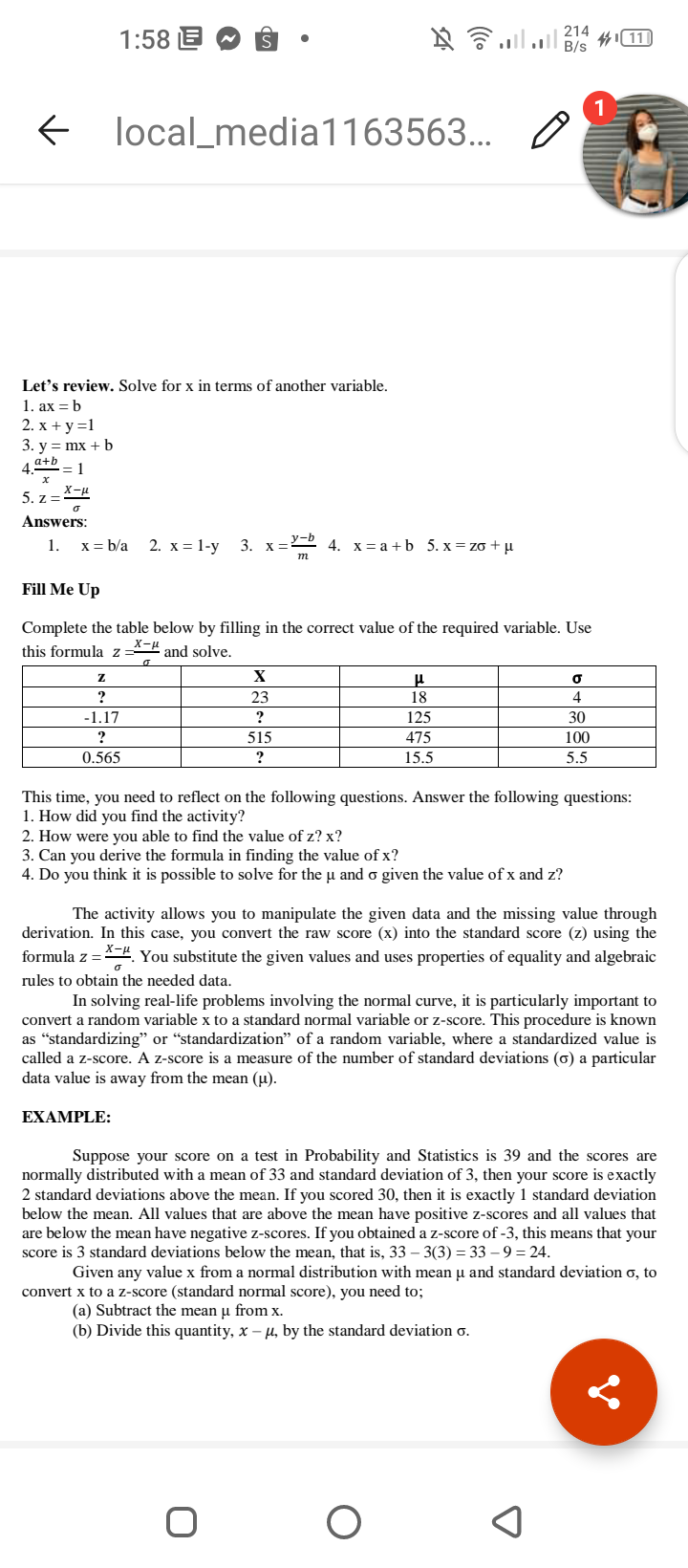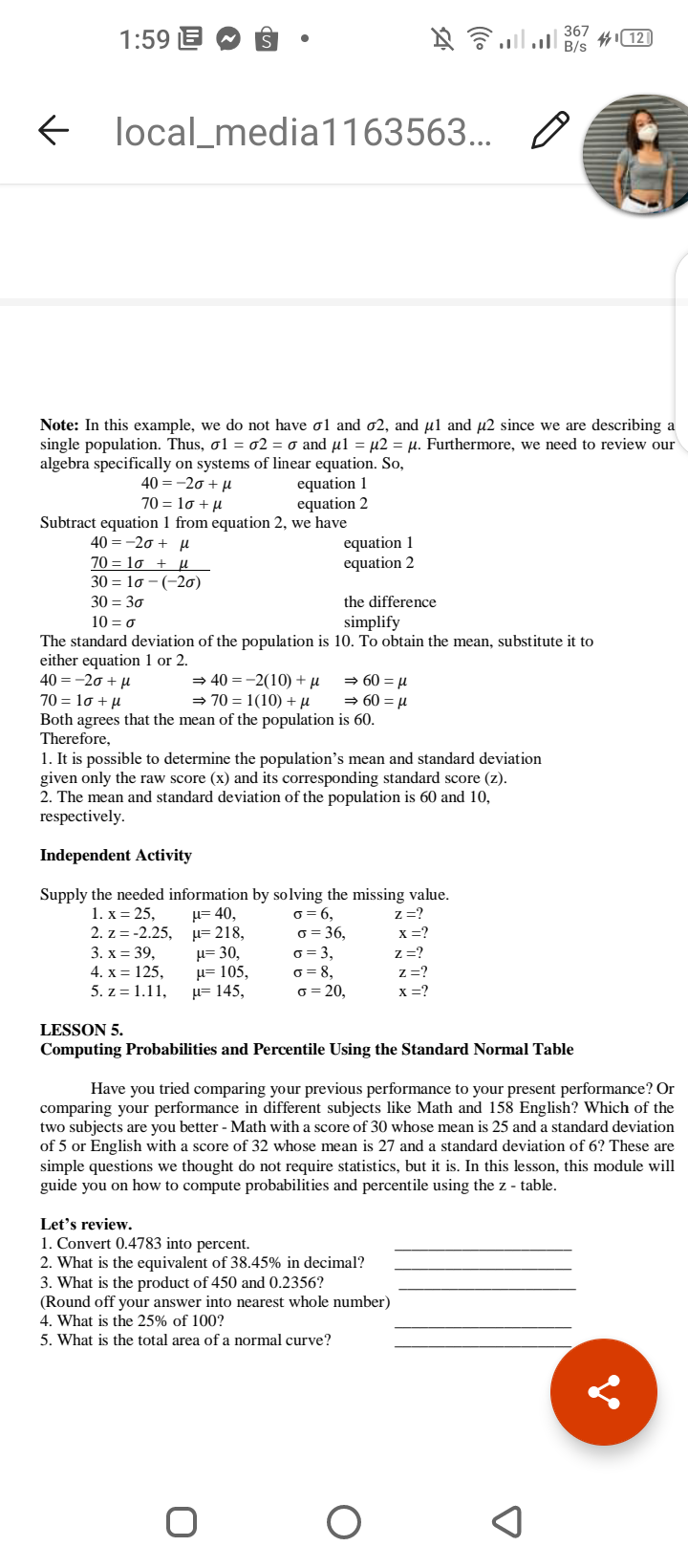Let's review. Solve for x in terms of another variable. 1. ах %3Db 2.х + у%31 3. у %3D mx + b 4. a+b = 1 X-u 5. z = Answers: 1. х%3Dba 2. х3 1-у 3. х%3D 4. х%3а+b 5. х %3D zo + и m
Let's review. Solve for x in terms of another variable. 1. ах %3Db 2.х + у%31 3. у %3D mx + b 4. a+b = 1 X-u 5. z = Answers: 1. х%3Dba 2. х3 1-у 3. х%3D 4. х%3а+b 5. х %3D zo + и m
Algebra and Trigonometry (6th Edition)
6th Edition
ISBN:9780134463216
Author:Robert F. Blitzer
Publisher:Robert F. Blitzer
ChapterP: Prerequisites: Fundamental Concepts Of Algebra
Section: Chapter Questions
Problem 1MCCP: In Exercises 1-25, simplify the given expression or perform the indicated operation (and simplify,...
Related questions
Question

Transcribed Image Text:214
1:58 E
ll
local_media1163563...
Let's review. Solve for x in terms of another variable.
1. ах %3Db
2. х + у%3D1
3. y = mx + b
4 a+b = 1
5. z =
Answers:
y-b
1.
X = b/a
2. x = 1-y
3. х-
4. x = a +b 5. x = zo + u
т
Fill Me Up
Complete the table below by filling in the correct value of the required variable. Use
this formula z
X-H and solve.
X
23
18
4
-1.17
?
125
30
?
515
475
100
0.565
?
15.5
5.5
This time, you need to reflect on the following questions. Answer the following questions:
1. How did you find the activity?
2. How were you able to find the value of z'
3. Can you derive the formula in finding the value of x?
4. Do you think it is possible to solve for the u and o given the value of x and z?
The activity allows you to manipulate the given data and the missing value through
derivation. In this case, you convert the raw score (x) into the standard score (z) using the
formula z = . You substitute the given values and uses properties of equality and algebraic
rules to obtain the needed data.
In solving real-life problems involving the normal curve, it is particularly important to
convert a random variable x to a standard normal variable or z-score. This procedure is known
as "standardizing" or "standardization" of a random variable, where a standardized value is
called a z-score. A z-score is a measure of the number of standard deviations (o) a particular
data value is away from the mean (u).
EXAMPLE:
Suppose your score on a test in Probability and Statistics is 39 and the scores are
normally distributed with a mean of 33 and standard deviation of 3, then your score is exactly
2 standard deviations above the mean. If you scored 30, then it is exactly 1 standard deviation
below the mean. All values that are above the mean have positive z-scores and all values that
are below the mean have negative z-scores. If you obtained a z-score of -3, this means that your
score is 3 standard deviations below the mean, that is, 33 – 3(3) = 33 – 9 = 24.
Given any value x from a normal distribution with mean u and standard deviation o, to
convert x to a z-score (standard normal score), you need to;
(a) Subtract the mean u from x.
(b) Divide this quantity, x – µ, by the standard deviation o.

Transcribed Image Text:367
1:59 E
local_media1163563..
Note: In this example, we do not have ol and o2, and µl and µ2 since we are describing a
single population. Thus, ơ1 = o2 = o and µl = µ2 = µ. Furthermore, we need to review our
algebra specifically on systems of linear equation. So,
40 = -20 + µ
equation 1
equation 2
70 = lo + µ
Subtract equation 1 from equation 2, we have
40 = -20 + H
70 = lo + µ
30 = lo - (-20)
30 = 30
equation 1
equation 2
the difference
10 = 0
simplify
The standard deviation of the population is 10. To obtain the mean, substitute it to
either equation 1 or 2.
40 = -20 + µ
70 = lo + µ
Both agrees that the mean of the population is 60.
= 40 = -2(10) + u
= 70 = 1(10) + µ
= 60 = µ
= 60 = µ
Therefore,
1. It is possible to determine the population's mean and standard deviation
given only the raw score (x) and its corresponding standard score (z).
2. The mean and standard deviation of the population is 60 and 10,
respectively.
Independent Activity
Supply the needed information by solving the missing value.
H= 40,
µ= 218,
µ= 30,
u= 105,
H= 145,
1. х %3D25,
2. z = -2.25,
3. х %3D 39,
4. x = 125,
5. z = 1.11,
o = 6,
o = 36,
o = 3,
o = 8,
o = 20,
z =?
x =?
z =?
z =?
x =?
LESSON 5.
Computing Probabilities and Percentile Using the Standard Normal Table
Have you tried comparing your previous performance to your present performance? Or
comparing your performance in different subjects like Math and 158 English? Which of the
two subjects are you better - Math with a score of 30 whose mean is 25 and a standard deviation
of 5 or English with a score of 32 whose mean is 27 and a standard deviation of 6? These are
simple questions we thought do not require statistics, but it is. In this lesson, this module will
guide you on how to compute probabilities and percentile using the z - table.
Let's review.
1. Convert 0.4783 into percent.
2. What is the equivalent of 38.45% in decimal?
3. What is the product of 450 and 0.2356?
(Round off your answer into nearest whole number)
4. What is the 25% of 100?
5. What is the total area of a normal curve?
Expert Solution
This question has been solved!
Explore an expertly crafted, step-by-step solution for a thorough understanding of key concepts.
This is a popular solution!
Trending now
This is a popular solution!
Step by step
Solved in 3 steps with 3 images

Knowledge Booster
Learn more about
Need a deep-dive on the concept behind this application? Look no further. Learn more about this topic, algebra and related others by exploring similar questions and additional content below.Recommended textbooks for you

Algebra and Trigonometry (6th Edition)
Algebra
ISBN:
9780134463216
Author:
Robert F. Blitzer
Publisher:
PEARSON

Contemporary Abstract Algebra
Algebra
ISBN:
9781305657960
Author:
Joseph Gallian
Publisher:
Cengage Learning

Linear Algebra: A Modern Introduction
Algebra
ISBN:
9781285463247
Author:
David Poole
Publisher:
Cengage Learning

Algebra and Trigonometry (6th Edition)
Algebra
ISBN:
9780134463216
Author:
Robert F. Blitzer
Publisher:
PEARSON

Contemporary Abstract Algebra
Algebra
ISBN:
9781305657960
Author:
Joseph Gallian
Publisher:
Cengage Learning

Linear Algebra: A Modern Introduction
Algebra
ISBN:
9781285463247
Author:
David Poole
Publisher:
Cengage Learning

Algebra And Trigonometry (11th Edition)
Algebra
ISBN:
9780135163078
Author:
Michael Sullivan
Publisher:
PEARSON

Introduction to Linear Algebra, Fifth Edition
Algebra
ISBN:
9780980232776
Author:
Gilbert Strang
Publisher:
Wellesley-Cambridge Press

College Algebra (Collegiate Math)
Algebra
ISBN:
9780077836344
Author:
Julie Miller, Donna Gerken
Publisher:
McGraw-Hill Education